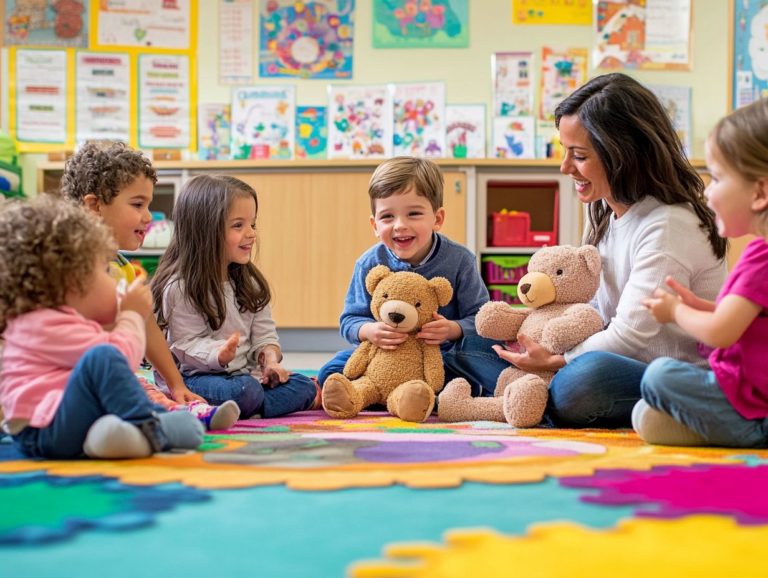Navigating Emotional Awareness as a Blended Family
Contents
- Navigating Emotional Awareness in Blended Families
- Key Takeaways:
- What Is a Blended Family?
- Challenges of Being in a Blended Family
- 2. Dealing with Co-parenting Conflicts and Shared Custody
- 3. Managing Different Parenting Styles and Coping Strategies
- 4. Navigating Step-parent/Step-child Relationships
- Why Is Emotional Awareness Important in Blended Families and Addressing Emotional Well-Being?
- How Can Emotional Awareness Help Blended Families and Improve Mental Health?
- Conclusion
- Practical Tips for Navigating Emotional Awareness in Blended Families
- 2. Encourage Open Communication
- 3. Validate Each Other’s Feelings
- 4. Seek Professional Help if Needed
- Frequently Asked Questions
- Why is navigating emotional awareness important for blended families according to the American Psychological Association?
- How can parents promote emotional awareness and emotional support in a blended family?
- What are some common emotional and behavioral challenges in blended families?
- How can stepparents navigate their role and provide family support in a blended family?
- What can family members do to support emotional well-being and mental health in a blended family?
Blended families are becoming increasingly common, uniting diverse backgrounds and creating unique family dynamics. This shift from the traditional nuclear family often involves navigating complex relationships and emotional well-being.
While the joys of merging families can be incredibly rewarding, you may encounter challenges along the way. These include adjusting to new relationships and navigating co-parenting conflicts. In this context, understanding emotional awareness is vital, as it significantly contributes to fostering healthy communication and nurturing essential relationships. The adjustment can sometimes lead to an adjustment disorder, impacting psychological well-being for all members.
In this article, you’ll discover the fascinating world of blended families, uncovering their challenges and powerful strategies for success! We will highlight the obstacles they face, including grief and behavioral challenges, and offer practical coping strategies to enhance emotional awareness. By doing so, you can cultivate stronger family bonds that withstand the test of time.
Key Takeaways:

- Adjusting to new family dynamics can be challenging for blended families.
- Emotional awareness is crucial in helping blended families navigate conflicts and build stronger relationships.
- Practicing active listening, encouraging open communication, and seeking professional help from therapists such as those at Heritage Counseling can aid in managing emotions in a blended family dynamic.
What Is a Blended Family?
A blended family represents a complex family unit that emerges when one or both partners in a new relationship bring children from prior relationships into the mix. This arrangement often gives rise to differing family dynamics, featuring step-parents, step-siblings, and various shared custody scenarios.
All of these require careful navigation of emotional well-being for the children while managing any parental conflicts that may arise. The nature of blended families can differ greatly; some maintain only occasional contact, while others reside together in a new household.
Ultimately, this creates a supportive family environment that fosters resilience and understanding, addressing the unique needs of the children involved.
Challenges of Being in a Blended Family
Being part of a blended family can bring a host of challenges that profoundly affect emotional well-being and mental health. You’ll find yourself navigating parental conflicts and adjusting to new family dynamics, which can be quite the balancing act.
Children in these families often encounter behavioral issues rooted in emotional turmoil. They grapple with disrupted attachments and the grief that comes from their previous family structures. These attachment disruptions can affect their academic performance and overall childhood experiences.
It’s essential to develop effective coping mechanisms to address these complexities. Ensuring that every family member feels supported and understood in their unique experiences is crucial.
1. Adjusting to New Family Dynamics and Coping with Emotional Well-Being
Adjusting to new family dynamics in a blended family requires patience and understanding. As each member navigates their unique emotional burdens, they work to build relationships within the new household. This adjustment period often involves establishing a family routine that includes everyone.
Fostering a sense of belonging and emotional support among children and step-parents alike is essential. Addressing emotional turmoil during this period is crucial for long-term stability.
You can greatly benefit from creating clear communication channels, where each family member feels encouraged to express their feelings and concerns in a safe environment. Holding regular family meetings can provide a constructive platform for discussing individual needs and collectively redefining family roles.
This kind of open dialogue is endorsed by organizations like the American Psychological Association. Incorporating regular family activities, whether it s game nights or outdoor adventures, can help strengthen bonds and create cherished memories.
By being attentive to the unique challenges each child faces and recognizing their emotional triggers, you can instill a sense of security and validation. This is vital for cultivating a harmonious blended family atmosphere and emphasizes the importance of emotional support in strengthening family resilience.
In conclusion, navigating the complexities of blended families requires understanding, communication, and emotional awareness. Implementing these strategies can lead to healthier relationships and a more supportive family environment.
Co-parenting conflicts can have a profound impact on emotional well-being within blended families. When unresolved issues linger between parents, they create a tension that can disrupt children’s needs and the overall harmony of the family. Addressed co-parenting approaches are needed to effectively manage these conflicts, especially in shared custody arrangements that require ongoing collaboration between ex-partners and current spouses. Employing effective communication strategies is essential.
Establishing open lines of dialogue fosters mutual respect, cultivating a healthier environment for everyone involved. You should prioritize active listening and empathy with each other’s perspectives, particularly when navigating the complexities of emotions or past grievances.
Consider utilizing tools such as regular family meetings or mediation services to ensure that discussions remain productive rather than devolving into adversarial exchanges. Ultimately, keeping the children’s best interests at the forefront can help alleviate tensions and strengthen co-parenting relationships, leading to enhanced emotional stability for your children. The family’s narrative should prioritize the well-being and psychological impact on the children.
This collaborative approach not only nurtures their well-being but also imparts valuable lessons to them about communication and conflict resolution.
3. Managing Different Parenting Styles and Coping Strategies
Managing various parenting styles within a blended family can present behavioral challenges, as children may find it difficult to adapt to the new rules and expectations set by their step-parents. It s crucial for you to understand and respect these individual parenting styles; after all, emotional support and a unified approach to meeting your children s needs can cultivate a harmonious family environment. Developing effective coping strategies will also help in managing these behavioral issues.
To navigate these complexities, you would benefit greatly from engaging in open dialogue where you express your values and concerns regarding child-rearing practices. Establishing regular family meetings allows everyone to discuss their differences constructively, creating a platform to align your approaches. By setting clear and consistent boundaries while still allowing each parent to maintain their unique style, you can provide your children with the stability they need amidst these changes. This can prevent adjustment issues as children adapt to new circumstances.
Encouraging working together and sharing tasks can further enhance the emotional support within the family, making children feel secure and valued. Ultimately, by aligning on fundamental principles while embracing the diversity in techniques, you can foster a nurturing atmosphere that honors each parent’s influence. This includes acknowledging the psychological impact that different parenting styles can have on children and addressing it proactively.

Navigating step-parent and step-child relationships requires intentional effort and emotional awareness to cultivate healthy connections within your blended family unit. You ll find that effective communication strategies and resilience from both step-parents and children are essential in building trust and understanding, ensuring emotional well-being is at the forefront of this evolving family dynamic. These efforts also help mitigate any behavioral challenges that may arise from disrupted attachment or emotional turmoil.
The complexities of these relationships often arise from differing expectations and experiences. As a step-parent, you might feel the weight of establishing authority, while children may grapple with feelings of loyalty toward their biological parent and the resulting emotional turmoil. Open dialogue is crucial in addressing these challenges, allowing both you and the children to express your feelings honestly. Providing emotional support is vital, as it helps children adjust to their new family structure with greater ease.
By investing time in shared activities and creating a sense of inclusion, you can foster a nurturing environment where healthy bonds can thrive. This commitment ultimately contributes to the stability and happiness of the entire family, creating a harmonious atmosphere for everyone involved.
Why Is Emotional Awareness Important in Blended Families and Addressing Emotional Well-Being?
Emotional awareness is essential in blended families, as it serves as the foundation for each member’s emotional well-being. It influences how individuals navigate the intricate dynamics and interpersonal relationships that arise within these unique family structures.
By cultivating emotional awareness, you create a space for effective communication and develop coping mechanisms that enable everyone to tackle challenges together. This collective effort ultimately fosters resilience and harmony within your household, allowing each member to thrive. These practices contribute to better mental health outcomes for all family members.
How Can Emotional Awareness Help Blended Families and Improve Mental Health?
Emotional awareness can greatly enhance the dynamics of blended families by helping family members talk better and minimizing conflicts, resulting in stronger relationships among family members. Enhanced emotional well-being contributes significantly to a supportive family environment.
When you take the time to understand and acknowledge each other’s feelings, you open the door to developing healthy coping mechanisms. This nurtures emotional well-being and supports a collaborative family atmosphere that thrives on mutual respect and understanding.
1. Improving Communication and Emotional Awareness
Improving communication in blended families is absolutely essential. It cultivates emotional awareness and understanding among family members, allowing everyone to express their feelings openly. By employing techniques such as active listening and fostering open dialogue, you can create a safe space where each person feels comfortable sharing their emotional experiences.
This approach leads to deeper connections and invaluable support, ultimately enhancing the resilience of the family. Practice empathy by putting yourself in each family member’s shoes and acknowledging the unique challenges everyone faces, especially those arising from divorce and new family dynamics.
Establish regular family meetings as a vital platform where all voices are valued and heard. This enables honest discussions about individual concerns and collective goals. Incorporating activities that promote team building will help strengthen the bonds among family members, making it easier for everyone to express their emotions.
By prioritizing these strategies, you can help your blended family cultivate a solid foundation of trust and open dialogue, ultimately enhancing your overall dynamics.
2. Reducing Tension and Conflict
Reducing tension and conflict in blended families is achievable through heightened emotional awareness and the implementation of effective coping strategies tailored specifically to your unique family dynamics. Acknowledge and address the underlying emotional issues, such as parental conflict and behavioral challenges, to cultivate a harmonious environment that prioritizes emotional well-being.
Each family member brings their own experiences and feelings to the table. Encouraging open communication enables everyone to express their thoughts and feelings without fear of judgment. This significantly reduces misunderstandings and addresses the unique emotional burden each one carries.
Regular family meetings serve as an excellent platform for discussing grievances and celebrating achievements, fostering a sense of unity. Techniques such as active listening and learning to understand each other better can help family members validate one another s emotions, strengthening their interpersonal connections and providing family support.
Ultimately, it’s all about building trust and respect essential components in your journey toward peaceful coexistence within blended families. This addresses the psychological impact of divorce and shared custody.
Conclusion
Emotional awareness is crucial for nurturing relationships in blended families. By prioritizing communication, reducing conflict, and understanding each other’s feelings, you can create a harmonious environment where everyone thrives. Take the first step today by starting family meetings to boost your family s emotional health!
3. Building Stronger Relationships
Building stronger relationships in blended families relies heavily on your emotional awareness. This awareness fosters trust and understanding among all family members. By prioritizing emotional well-being and creating a supportive environment, you can cultivate deeper connections that elevate the overall family dynamics.
This emotional intelligence serves as a solid foundation. It allows you and your family members to express feelings openly and honestly. This is a crucial aspect of blending different backgrounds and experiences. When everyone in these families becomes attuned to each other’s emotions, you learn to navigate conflicts with empathy. This paves the way for mutual respect and cooperation, addressing attachment disruption.
Validating one another’s feelings reinforces the idea that every voice matters. This encourages a profound sense of belonging. Ultimately, when you invest in building emotional awareness, you not only strengthen your family bonds but also create a safe haven where trust thrives. Every member feels valued and supported. This is particularly important for addressing children s needs and grief that may arise from divorce.
4. Promoting Healthy Coping Mechanisms

Promoting healthy coping mechanisms within blended families is essential. This nurtures resilience and emotional well-being, especially when faced with unique challenges. By cultivating emotional awareness, you enable family members to identify and develop effective coping strategies that resonate with your family’s distinct dynamics. This addresses adjustment disorder.
Recognizing and understanding emotions not only fosters empathy among family members but also paves the way for open communication. This is crucial for resolving conflicts. When you prioritize emotional awareness, you become more attuned to the feelings of others. This allows you to adapt your responses and create a nurturing environment. This supportive atmosphere encourages both children and adults to freely express their needs and challenges. It fosters trust and deeper connection, addressing academic performance.
Implementing healthy coping mechanisms, such as mindfulness practices or family discussions, can greatly enhance family cohesion. This enables you to navigate your diverse experiences together, address emotional turmoil, and ultimately lead to a more harmonious household. Everyone feels valued and understood.
Implementing practical strategies for navigating emotional awareness in blended families can greatly elevate communication. It promotes emotional well-being among all family members, addressing the psychological impact of divorce and adjustment disorder.
Approaches like active listening and seeking professional help when necessary can cultivate a supportive atmosphere. This fosters healthy relationships and effective coping strategies, as recommended by the American Psychological Association.
By embracing these methods, you can create a harmonious family dynamic that thrives on understanding and connection. This addresses both mental health and behavioral challenges.
1. Practice Active Listening
Practicing active listening is essential for fostering emotional awareness in blended families. It demonstrates empathy and validates each family member’s feelings. By prioritizing open communication and genuinely engaging with one another, you can create a strong support system. This nurtures emotional well-being and addresses attachment disruption.
To enhance your active listening skills, consider techniques such as maintaining eye contact, reflecting back what you hear, and asking clarifying questions. These strategies can significantly deepen understanding and connection among family members. The benefits of active listening extend far beyond simple conversation; they help cultivate an environment of trust where everyone feels safe to express their vulnerabilities and concerns, addressing issues that may arise in childhood experiences.
When family members feel heard, they’re more likely to contribute positively to discussions. This leads to stronger bonds and a harmonious atmosphere. This not only aids in emotional growth but also equips families with the skills necessary to navigate challenges effectively. It allows supporting one another through life s ups and downs, including psychological impact and emotional support.
Start today to cultivate your family s emotional awareness for a happier life together!
2. Encourage Open Communication
Encouraging open communication within blended families is essential for fostering understanding of feelings and strengthening relationships among all family members. By cultivating an environment where everyone feels comfortable expressing their thoughts and feelings, you can navigate the complexities of your family dynamics more effectively and address adjusted co-parenting, which involves adapting parenting styles after separation or divorce.
This becomes even more critical in blended families, where individuals may be adjusting to new roles and relationships after significant life changes. By prioritizing open dialogue, each family member can share their unique perspectives and experiences, which helps in building empathy and understanding.
Discussing emotions candidly can significantly reduce conflicts and misconceptions, creating a stronger sense of belonging and addressing the unique emotional burden each family member carries.
Implementing healthy communication practices, such as regular family meetings or one-on-one check-ins, can further enhance emotional intelligence and allow connections to deepen. When family members learn to communicate openly, everyone is better equipped to support one another during challenging times, reinforcing the overall stability of your relationships and addressing family routine.
3. Validate Each Other’s Feelings
Validating each other’s feelings is an essential practice for promoting understanding of feelings in blended families. This approach fosters a profound sense of belonging and support among all family members. By acknowledging and respecting everyone’s emotions, you can build resilience and enhance overall family dynamics.
This practice creates a safe space for open dialogue and encourages you and your loved ones to express yourselves freely, knowing that your feelings are genuinely recognized. In blended families, where diverse backgrounds often intersect, validation becomes a cornerstone for unity and understanding.
When stepfamily members openly discuss their emotions whether it’s joy, frustration, or anything in between it cultivates empathy and shared experiences, addressing both children and step-parent relationships.
Understanding feelings is crucial for bridging gaps that different family cultures might create, ultimately leading to healthier relationships. It lays the foundation for effective conflict resolution, allowing you and your family members to navigate disagreements with kindness and consideration while addressing co-parenting challenges.
4. Seek Professional Help if Needed
Don t hesitate to seek professional help; it can be a game changer for blended families grappling with emotional challenges. Therapists can offer expert guidance in navigating complex family dynamics and enhancing emotional well-being. Their support proves instrumental in conflict resolution and nurturing healthier relationships among family members, especially in understanding and addressing the psychological impact of divorce.
Engaging in counseling or therapy provides a structured environment for you to express your feelings and experiences openly, fostering trust and understanding. Family therapy, in particular, invites all members including stepparents and children to voice their concerns and collaborate on shared goals.
Through these sessions, you can learn effective communication techniques, develop coping strategies, and address underlying issues, ultimately reinforcing your family bond and addressing the family narrative.
Therapists also equip families with essential tools to manage transitions and cultivate a balanced family culture, making it easier for you to navigate the unique challenges that blended families often face, as supported by Heritage Counseling.
Frequently Asked Questions

What is a blended family?
A blended family is a family unit that consists of a couple and their children from previous relationships. It is formed when two individuals with children from previous relationships come together to create a new family. Blended families often face unique emotional and behavioral challenges distinct from a nuclear family. Additionally, blended families may need to navigate shared custody and adjusted co-parenting to effectively meet children s needs.
Navigating emotional awareness is crucial for blended families because it helps family members understand and manage their emotions towards one another. This is especially important as blended families often face unique challenges, such as grief, emotional struggles, and new family narratives. These challenges can lead to emotional turmoil and stress.
How can parents promote emotional awareness and emotional support in a blended family?
Parents can promote emotional awareness by fostering open communication and actively listening to their children’s feelings. They should validate their emotions as well. Parents should also show how to express emotions healthily, resolve conflicts, and employ coping strategies, which are methods to handle stress. Addressing parental conflict and emotional struggles openly helps build a resilient family unit.
What are some common emotional and behavioral challenges in blended families?
Some common emotional challenges in blended families include feelings of rejection or jealousy from stepchildren and loyalty conflicts between biological and stepparents. Attachment disruption is another challenge, as is adjusting to new family dynamics and roles. Addressing these challenges is vital for managing the unique emotional burden and psychological impact on children and parents.
Stepparents can navigate their role by building a positive relationship with their stepchildren, being patient and understanding, and setting realistic expectations. It is also important for stepparents to communicate openly with their partner and work together as a team in co-parenting. Using effective communication strategies and understanding childhood experiences helps manage behavioral challenges successfully.
What can family members do to support emotional well-being and mental health in a blended family?
Family members have an exciting opportunity to enhance emotional well-being in a blended family by practicing empathy and respecting boundaries. They should also be patient and understanding. Having regular family meetings is crucial for addressing concerns promptly and engaging in open dialogue to find solutions together. Incorporating family routines and support systems can significantly enhance emotional stability and promote adjustment disorder management.






